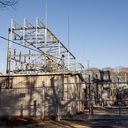U.S. homelessness reached another record high in 2024
U.S. homelessness increased 18% this year, according to federal data released on Friday, with children being the age group that experienced the largest increase.
The big picture: Homelessness among nearly all populations reached record levels this year, but of the exacerbating factors have balanced out since the survey was conducted in January, the Department of Housing and Urban Development said in its report.
By the numbers: More than 770,000 people experienced homelessness on a single night in January 2024, per the point-in-time survey.
- Nearly 150,000 children experienced homelessness when the survey was taken, reflecting a 33% increase over 2023.
- Black people were 32% of the population identifying as homeless, despite making up 12% of the total U.S. population, HUD said. This figure decreased from 37% in 2023.
- Veterans reported continued declines in homelessness, decreasing by 8%.
Context: The migrant crisis, wildfires in Maui, Hawai'i that displaced thousands and high housing costs contributed to the stark rise and record high in the HUD report.
- "In the 13 communities that reported being affected by migration, family homelessness more than doubled," per HUD. Meanwhile, "in the remaining 373 communities, the rise in families experiencing homelessness was less than 8%."
- Chicago and Denver both announced an end to their migrant shelter systems this fall in response to decreases in shelter censuses.
Zoom in: "This report reflects data collected a year ago and likely does not represent current circumstances, given changed policies and conditions," HUD said in a statement.
- The survey was taken at the end of significant rental cost increases. Since then, rents have flattened or decreased.
- Rental costs have also stabilized since Maui wildfires exacerbated the housing crisis.
- And migration that rose 39% from 2023 to 2024, dropped later this year with more control on border crossings, HUD said.
Zoom out: Issues around poverty and homelessness got almost no attention during the 2024 election with candidates focusing on middle class concerns.
- A broad measure of poverty for families headed by single mothers rose last year and is now back to 2018 levels, per a new analysis of Census Bureau data from the National Women's Law Center.
- For households led by single mothers, the supplemental measure of poverty increased to 29% in 2023 from 27% in 2022. That's more than 2.7 million families.
The nation's overall poverty rate is 12.4% but it is 21.3% for Black people and 16.9% for Latinos, based on the Census Bureau's 2023 5-year estimates.
- Latinos make up 19% of the population and with other people of color, are set to form a plurality of the country's population by midcentury, but experts say a lack of discussion on Latino poverty is allowing inequalities, and possibly homelessness, to fester and grow.
- Rev. William Barber, of the Poor People's Campaign, tells Axios that the lack of discussion on poverty and low-wage workers prevents the nation from having an honest look at unhoused populations and affordable housing.
Go deeper:
- Homelessness in the U.S. jumped to record level in 2023, government says
- A record 1 in 8 NYC students experienced homelessness last school year





















